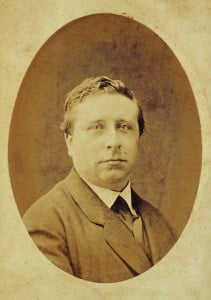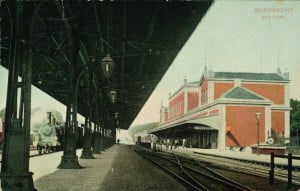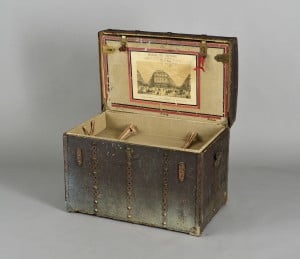A Grey Suit for Travelling
The 19th century Dutch banker Simon van Gijn travelled often and enthusiastically. He filled one notebook after another with his experiences while travelling Europe by rail. Curator Wyke Sybesma of the House van Gijn had been studying these notes for months before she decoded them. They revealed a treasure trove of information about travelling by train in the 19th century.
On Sunday 4 August 1889, Simon van Gijn is waiting at the station of his hometown, Dordrecht. It’s early: his train is due to depart at 08.24 am.
Maybe Van Gijn came to the station by foot. More likely, he rented a horse-drawn carriage. Van Gijn, you see, is a banker and a lawyer and it’s quite unusual for a wealthy person of note to walk to a station. Moreover, he’s carrying a lot of luggage: he’s about to start travelling throughout Germany for a couple of weeks.
Maybe Van Gijn has brought a big, wooden trunk, the sort with brass fittings that people often used for travelling in the 19th century. It would be big enough for shoes, boots, a walking stick, a hatbox and a tail-coat. Unfortunately, we don’t know for sure, since his suitcases weren’t preserved. What we do know is that Van Gijn travelled with two suitcases, every time. He made sure to write that down in his notes.
Dusty as a Chimney Sweep
The steam train is ready and champing to set off. The driver gives a blast on the whistle and a cloud of grey smoke spreads through the station. Travelling by train makes one dirty, as Van Gijn knows. While travelling three years before, he wrote: ‘What bothered us most was the dust that made us look like chimney sweeps upon arrival.’ For that reason, he always wears his grey suit for travelling, as it makes the dust less visible. He also mentions that it’s a good idea to travel with your back to the engine. You’ll suffer less from the dust and the airstream.
The porters have carried his suitcases on board and he himself has stepped into the first-class coach. ‘The weather is variable. Rain and sun are taking turns,’ he writes in his notebook. The journey takes him through cities such as Venlo and Oberhausen to Hanover. At 5.53 pm he will arrive at the last station and will move into the Hotel Royal.
Crabbed Handwriting
Simon van Gijn lived from 1836 to 1922 and produced a countless number of notebooks with reports of his travels. Nineteen have been preserved and form part of the collection in the Huis van Gijn in the Dutch city of Dordrecht. The museum is in the house where Van Gijn used to live in the historic city centre.
Curator Wyke Sybesma read all nineteen journals. ‘He wrote every word in crabbed handwriting with a pencil. To prevent the letters from fading, we copied every page. Then a colleague and I typed everything. For months I was working on the project every single night,’ the 31-year-old art historian tells us. ‘It turned out to be a treasure trove of information. I became more and more fanatical about it. When I came across a word that was unclear, I wouldn’t rest until I found out what it said.’
Besides the notebooks, there are also a few travel guides (the famous Baedecker guides, for example), city plans and entrance tickets in the collection. By combining these with Van Gijn’s notes, Wyke could track his moves quite precisely. She points out a ‘walking tour’ in the Coaching Guide to North Wales from 1899, which Van Gijn marked with a little cross in the book. ‘He did that tour. In one of his notebooks he mentions it as being a stunning, diverse tour.’
To Paris in Eleven Hours
The travel times didn’t differ that much from those of today, Wyke discovered. ‘In around two hours, you could travel from Amsterdam to Dordrecht. And the journey from Köln to Dordrecht took five hours. That’s only an hour and a half longer than it takes now.’ Still, travel in general was time consuming. To reach Paris, for example, you’d be on the move for eleven hours. ‘At the destination you would usually take a horse-drawn carriage. At times Van Gijn reports that he used the electric tram. He specifically adds ‘electric’ since it was something very special at the time.’
Whether Van Gijn viewed train travel as something romantic is not clear from his notes. Wyke: ‘It wasn’t as if he had to choose to take the train. Alternatives like the car or plane weren’t possible. I think he enjoyed his journeys, nonetheless. If he had hated the hassle, he wouldn’t have travelled that often.’
The exhibition ‘Op reis met Van Gijn’ (‘Travelling with Van Gijn’, ed.) runs until 25 May 2015 at the Huis van Gijn at Nieuwe Haven 29-30 in Dordrecht, Holland.
___________
![]()
 About the author: After a career in education, Saskia Lensink switched to a career in journalism in 2010. She draws up people’s life stories for Dutch Daily ‘Algemeen Dagblad’, writing about culture, history and business. What’s more, she’s working on a book about daily life during the second world war in her hometown Dordrecht, which is due in April 2015.
About the author: After a career in education, Saskia Lensink switched to a career in journalism in 2010. She draws up people’s life stories for Dutch Daily ‘Algemeen Dagblad’, writing about culture, history and business. What’s more, she’s working on a book about daily life during the second world war in her hometown Dordrecht, which is due in April 2015.
About us: Story Terrace helps customers to capture personal stories in beautiful books alongside a professional writer. Our writers have a range of backgrounds and interests, sharing one passion: Portraying individuals through carefully crafted anecdotes and lively stories.
For more information on having your stories written down, send an e-mail to info@ or get in touch via our contact form.
This month we serve up stories in our monthly theme ‘Romance of the Railways’. Also read our article Focus on: early 20th century train travel. What’s your fondest memory of train travel?





